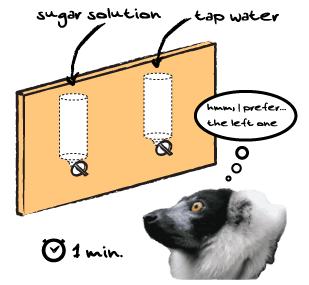Animals
Testing was carried out using three male black-and-white ruffed lemurs (V. variegata), in this study referred to as Subject (S) 1, 2 and 3.
Procedures
Taste preference thresholds and the relative preferences for the tested sugars were assessed using a two-bottle preference test of short duration. Each test comprised of two trials (for a total of four trials per individual and day) in which each animal was allowed 1 min to drink from a pair of simultaneously presented graduated bottles with metal drinking spouts. Each pair of stimuli was presented for a total of ten times per individual, with the positions of the bottles pseudo-randomized to counter possible position bias.
Experiment 1 - Determination of taste preference thresholds
To determine preference threshold values, the animals were given the choice between tap water and a predetermined concentration of sugar solution prepared with tap water. The tested concentrations for all saccharides ranged between 10 mM up to 200 mM and testing did not follow a strictly descending or ascending order of concentrations. Instead, the testing sequence was pseudo-randomized in order to keep up the animals’ motivation to cooperate. The lowest concentration of a saccharide that was significantly preferred over tap water was considered as the preference threshold value.
Experiment 2 - Assessment of relative preferences
The relative preference for the five saccharides was assessed using the same method as outlined above. However, in this experiment the lemurs were given the choice between two saccharide solutions (prepared with tap water) presented at equimolar concentrations. All possible binary combinations of the five saccharides, i.e. ten combinations, were tested. To assess whether relative preferences were stable at different concentrations, three series of tests were performed at 50, 100 and 200 mM, respectively.

Responsible for this page:
Director of undergraduate studies Biology
Last updated:
06/09/14
